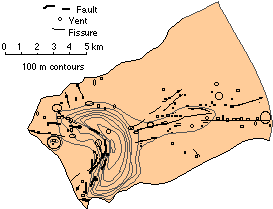|
Description of the Galapagos Islands Volcan Ecuador  | | A topographic map of Volcan Ecuador. Figure source:http://www.geo.cornell.edu/geology/GalapagosWWW/VEcuador.html |
Volcan Ecuador is located at the northwestern end of Isla Isabela and is one of the most geologically puzzling features in the Galapagos. The other Isabelan volcanoes are nearly radially symmetric, but Volcan Ecuador is certainly not. It appears to be missing its entire western half. Furthermore, both the northern and southern flanks are much steeper than usual and are clearly not constructional surfaces. These flanks have apparently been oversteepened by erosion or faulting, or both.
It is unclear whether Volcan Ecuador has simply grown with its present amphitheater-like morphology, or whether the western half of the volcano was faulted down into the sea or simply eroded away. Because Volcan Ecuador is in the rain shadow of other Isabelan volcanoes, its climate is very dry, hence the only mechanism for erosion is waves. Its seems extremely unlikely that waves alone could have eroded away the entire western half of the volcano, or produred the oversteepening of the northern flanks (though they are clearly responsible for some of the cliffs in the south). On the other hand, extremely large landslides have been documented on the Hawaiian volcanoes. Large slices of the Hawaiian volcanos appear to have slipped into the sea along accruate faults. It is certainly possible that the western half of Volcan Ecuador was lost in a just such a catestrophic landslide. If so, it probably produced and enormous tsunami (some times called a tidal wave.) Whatever its evolution, Volcan Ecuador does have a caldera, like its neighbors in the western Galapagos. A view into the caldera shows that the present floor, barely above sealevel, is covered by young fresh lava. A bench surrounding this may be the remenant of an earlier caldera.
An other interesting aspect of Volcan Ecuador is that the chemistry of its lavas, particularly in trace element and isotopic composition is quite distinct from that of its neighbor, Volcan Wolf. Furthermore, the composition of these lavas shows significant variation, in contrast to the very homogeneous character of the other Isabelan volcanos. Possibly, Volcan Ecuador is younger than the other volcanos and has not yet developed the mature plumbing system that produces homogeneous lavas. A team of geologists from Cornell University, the University of Idaho, the Ecole Normale Superieure de Lyon, and Lawrence University visited Volcan Ecuador in January of 1997. Their research program should provide answers to some of the questions about Volcan Ecuador in the next few years.
Volcan Ecuador could easily be mistaken for the remenant of a extinct volcano (and indeed was in some early geological studies). However, although there have been no reported historic eruptions, its central caldera and northern and eastern flanks are covered by many young lavas flows, some of which are probably not more than a few hundred years old. A fissure zone that runs east-northeast toward Volcan Wolf has been particularly active, and is constructing a ridge between the two volcanos. It is possible that within the last 10,000 years or so, Volcan Ecuador was an island. Thus whatever its history, Volcan Ecuador is quite active, and is most likely still in a relatively youthful stage.
|







